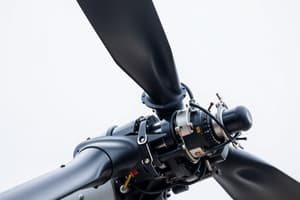Podcast
Questions and Answers
What is the main purpose of the rotor system in a helicopter?
What is the main purpose of the rotor system in a helicopter?
- To generate lift (correct)
- To hold the fuel
- To stabilize the helicopter during flight
- To house the cabin
The fuselage of a helicopter is primarily made up of wood.
The fuselage of a helicopter is primarily made up of wood.
False (B)
Name one material commonly used in the construction of helicopter airframes.
Name one material commonly used in the construction of helicopter airframes.
Aluminum
The __________ is the main body section of the helicopter that holds the cabin.
The __________ is the main body section of the helicopter that holds the cabin.
Match the following helicopter components with their functions:
Match the following helicopter components with their functions:
What is the primary purpose of the tail rotor system in helicopters?
What is the primary purpose of the tail rotor system in helicopters?
The Fenestron tail rotor uses rotating blades that are exposed to the environment.
The Fenestron tail rotor uses rotating blades that are exposed to the environment.
What are the three classifications of main rotor systems?
What are the three classifications of main rotor systems?
The __________ effect is a phenomenon used by the notar antitorque system to control direction.
The __________ effect is a phenomenon used by the notar antitorque system to control direction.
Match the following rotor systems with their characteristics:
Match the following rotor systems with their characteristics:
Flashcards are hidden until you start studying
Study Notes
Helicopter and Propeller Design
- Rotors serve as rotating airfoils, generating lift similar to fixed-wing aircraft wings by creating negative pressure above their curved surfaces.
Major Components of Helicopters
- Helicopters are composed of several major components: airframe, fuselage, main rotor system, tail rotor, and powerplant.
Airframe
- Constructed from various materials including metal, wood, composites, and titanium to ensure reliability and performance.
- Designs vary from tubular to sheet metal structures, integrating engineering and materials technology.
Fuselage
- Acts as the main body of the helicopter, enclosing the cabin, crew, passengers, cargo, engine, avionics, and flight controls.
- Can be built using truss-type or semi-monocoque structures and often incorporates advanced composites for strength and weight savings.
- Visibility from the cockpit is vital due to the multidirectional nature of helicopter flight.
Main Rotor System
- The main rotor system is essential for lift; it comprises a mast, hub, and rotor blades.
- The mast is a hollow cylindrical shaft that connects to the transmission, with the hub at its top serving as the attachment point for rotor blades.
- Main rotor systems can be categorized as rigid, semirigid, or fully articulated based on the rotor blade design.
Tail Rotor (Anti-Torque System)
-
Regulates thrust to maintain directional control as the main rotor torque changes or to adjust headings while hovering.
-
Typically driven by the transmission to ensure control in the event of engine failure.
-
Fenestron design employs a shrouded series of rotating blades within a vertical tail, enhancing safety by reducing the risk of contact with objects or personnel.
-
Notar system uses a fan system that generates low-pressure airflow, providing directional control while being resistant to foreign object damage (FOD).
Engine/Powerplant
- Reciprocating engines (piston engines) are commonly used in smaller helicopters due to their simplicity and cost-effectiveness.
- Turbine engines are more powerful, suitable for various helicopter types, and deliver high power relative to size, though they are generally more costly to operate.
Turbine Engines
- Turbine engines feature components like a compressor, combustion chamber, turbine, and accessory gearbox assembly.
- The compressor draws in and compresses air, which is mixed with fuel and ignited to create expanding gases that drive the turbine wheels.
- In most turbine setups, the first and second stage turbines operate independently on separate shafts, referred to as a "free turbine," maximizing efficiency and power distribution.
Studying That Suits You
Use AI to generate personalized quizzes and flashcards to suit your learning preferences.




